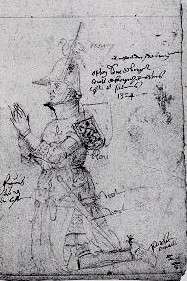Otto IV, Count of Burgundy
| Otto IV | |
|---|---|
| Count of Burgundy | |
 Otto IV, Count of Burgundy | |
| Spouse(s) |
Philippa of Bar Mahaut of Artois |
|
Issue | |
| Noble family | House of Ivrea |
| Father | Hugh de Châlon |
| Mother | Adelaide, Countess Palatine of Burgundy |
| Born |
1248 Ornans |
| Died | 1302 |
Otho IV, Count of Burgundy (1248, Ornans – 1302) was the son of Hugh de Châlons and Adelaide, Countess Palatine of Burgundy. Via his mother, he was a grandson of Countess Beatrice II of Burgundy. Via his father, he was descended from another branch of the Counts of Burgundy.
Upon his father's death in 1266/1267, he became Count of Châlons. His mother, Adelaide, died on March 8, 1279, and Otto inherited the County. However, he was unable to secure real power in the County until 1295. His son and elder daughter Jeanne II would eventually succeed him in the County of Burgundy.
His wife Mahaut drew up a contract on June 4, 1312 with the famous tomb maker Jean Pepin de Huy to make a tomb. The contract specifies a tomb made of stone and alabaster. Otto was to be shown as an armed knight with a shield, sword and armor. A lion was shown beneath his feet. Two angels would support the pillow under his head. This tomb no longer exists today, but the designs were preserved.[1]
Marriage and children
He married Philippa of Bar in 1271. The marriage was childless.
He married his second wife, Mahaut of Artois, in 1285.[2] They had three children:
- Joan (1292/8 - 1330) married Philip V of France [3]
- Blanche (1296/7 - 1325/6) married Charles of La Marche the future Charles IV of France.[3]
- Robert (1300 – 1315).
References
- ↑ Frisch, TG, Gothic art 1140-c. 1450: sources and documents, University of Toronto Press, 1987, ISBN 978-0-8020-6679-4 Googlebooks
- ↑ Philippe Le Bel et la Noblesse Franc-Comtoise, Frantz Funck-Brentano, Bibliothèque de l’École des chartes, Vol. 49 (1888), 12.
- 1 2 Blanche of Artois and Burgundy, Chateau-Gaillard, and the Baron de Joursanvault, Elizabeth A.R. Brown, Negotiating community and difference in medieval Europe: gender, power, patronage, and the authority of religion in Latin Christendom, ed. Katherine Allen Smith, Scott Wells, (BRILL, 2009), 223.